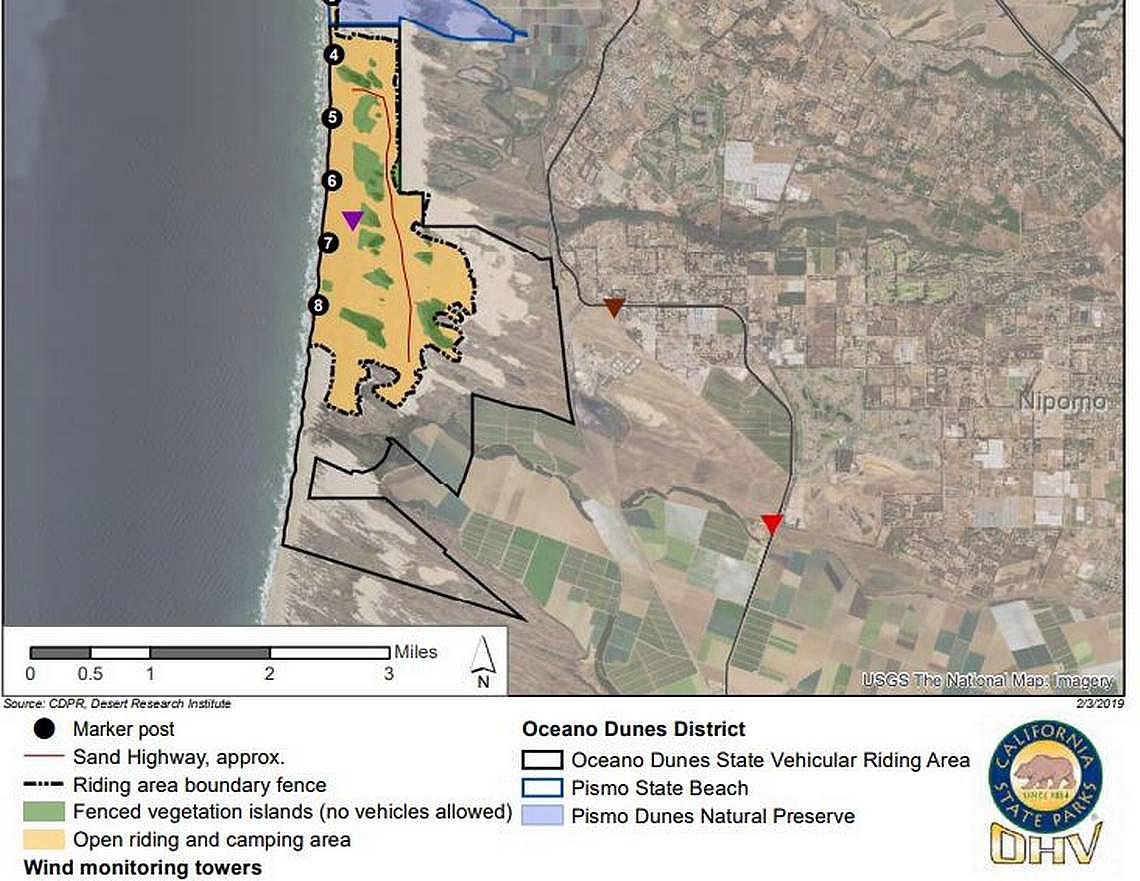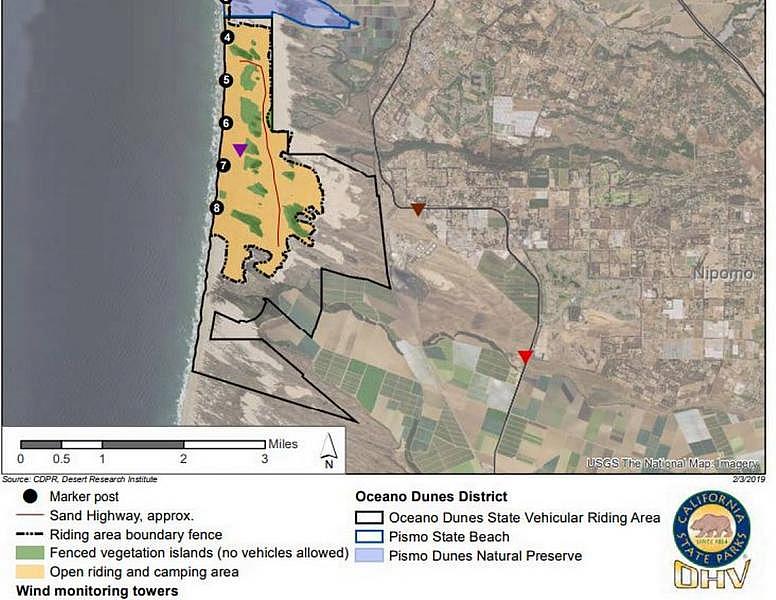State Parks released a new plan on how it will cut half of the dust emissions from the Oceano Dunes State Vehicular Recreation Area — just weeks after the agency said it was uncertain if meeting the goal “is feasible from an economic and logistical standpoint.”
Scientific analysis and modeling of dust from riding areas indicate that at least 500 acres (including 132 acres already closed off) of dust control measures — like planting native plants in areas that were vegetated in the 1930s — would reduce emissions from the park by as much as 36 percent and 51 percent, according to State Parks and the county Air Pollution Control District.
The theory is that vegetation prevents small sand particles from becoming airborne and blowing into nearby communities. Vehicles on the beach, however, are thought to disrupt a natural crust that forms on sand, prevent vegetation from growing, and grind sand into smaller particles that are easily lifted by the ocean breeze.
The plan outlines a timeline that includes the following actions:
- Hiring a project manager to oversee implementation of the plan: State Parks is in the process of recruiting for this position and hopes to have the job filled by July.
- Developing a natural foredune area: State Parks plans to apply for environmental permits to plant vegetation in the foredunes this summer; propagate native plants from April 2019 to February 2020; fence areas from October 2019 to November 2019; plant from December 2019 to February 2020; monitor from May 2019 to December 2023, conduct an education campaign from August 2019 to December 2020, hold public workshops in February 2020, and modify camping between March 2020 and December 2023.
- Converting existing wind fence areas to vegetation cover: State Parks will collect native plant seeds from June 2019 to September
- 2020; propagate from April 2019 to November 2020; remove fencing from September 2019 to October 2020; add mulch from October 2019 to November 2020; plant from December 2019 to February 2020; and survey and monitor from December 2019 to December 2023.
- Installing seasonal temporary wind fencing, and restoring backdune areas to natural vegetation as necessary.
A map of the Oceano Dunes State Vehicular Recreation Area shows locations in green that would be fenced off from off-road riding and revegetated. California State Parks
The 500-acre estimate is subject to change based on real world measurements of progress each year. And APCD Director Gary Willey previously said that it will likely take fewer than 500 acres of vegetation to meet the the settlement goal that State Parks agreed to when it settled a nuisance complaint in 2018.
Relief can’t come soon enough to residents of the Nipomo Mesa who live with high levels of airborne particulate matter that is known to cause respiratory illness and asthma. Just in the last week, high winds have prompted the APCD to alert residents of the Mesa about the blowing dust on three separate days.
While Willey and a scientific advisory group both said that the document State Parks submitted more than a month ago was inadequate, on Monday he said the new document is workable and that “this guidance document will get us there.”
APCD alleged that State Parks is responsible for a significant amount of particulate matter that blows into downwind communities during high winds, mostly in the spring. State Parks denies responsibility for air quality that violates state standards dozens of days each year, and instead points to a natural process of saltation as the sole culprit.
Nevertheless, State Parks agreed to reduce dust emissions from the area by 50 percent by 2023.
If State Parks reneged on its settlement agreement, the issue would return to the Air Pollution Control District Hearing Board, where board members could rule that State Parks is responsible for violating several state and local air quality rules and could potentially order the park closed.
Willey said he prefers the method of actively revegetating the area to help control dust.
“A total restoration of the dunes will take more than five years. Nature just won’t do that. However, we’ll get massive controls in this next five years,” Willey said. “Without any riding, it would restore in decades (naturally). We’re going to make it happen faster.”
Dunes riders, who call the park Pismo Dunes, will likely continue to be disappointed in State Parks willingness to cooperate with the enforcement effort, as they’re frustrated that hundreds of acres of riding has been lost over the years.
The locally impacted community and vehicle enthusiasts are likely to attend a public meeting about State Parks’ new plan. The meeting will be held 6 p.m. May 1 at the South County Regional Center at 800 West Branch St. in Arroyo Grande. Comments on the plan can be submitted to info@slocleanair.org.
To view documents about the issue, including the new draft plan, visit SLOCleanAir.org/air-quality/oceano-dunes-efforts.php.
[This article was originally published by The Tribune.]



